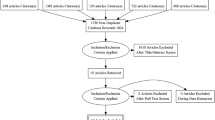Abstract
Objective
To compare the image quality of contrast-enhanced magnetic resonance angiography (CE-MRA) of the supra-aortic vessels at 0.05 mmol/kg bw and 0.1 mmol/kg bw, between gadobutrol, Gd-DTPA and Gd-BOPTA quantitatively and qualitatively a total of eight pigs were evaluated intraindividually at 1.5 T.
Methods
Each pig was examined using 0.1 mmol/kg gadobutrol, Gd-DTPA and Gd-BOPTA on day one and 0.05 mmol/kg on day two. MRA datasets for the carotid artery and the infraorbital artery were qualitatively assessed regarding overall image quality on an ordinal four-point scale (4-excellent, 1-non-diagnostic). The signal-to noise-ratio (SNR) was measured.
Results
The qualitative assessment of the carotid artery showed a higher median image quality for the 0.1 mmol dose than for the 0.05 mmol dose for all three compounds. No difference was found for the infraorbital artery. Mean SNR of Gd-BOPTA, Gd-DTPA, gadobutrol at 0.05 mmol/kg were 36.0 ± 13.4/37.9 ± 16.3/43.7 ± 0.4 and at 0.1 mmol/kg they were 50.1 ± 12.4/46.6 ± 6.5 / 54.6 ± 10.2. Gd-BOPTA 0.05 revealed a significantly lower SNR than all other agents at normal dose.
Conclusions
Full-dose gadolinium MRA results in higher image quality and significantly higher SNR compared with the half dose. Gadobutrol and Gd-BOPTA have similar enhancement properties at full dose but at half dose, gadobutrol appears superior.




Similar content being viewed by others
References
Leiner T (2005) Magnetic resonance angiography of abdominal and lower extremity vasculature. Top Magn Reson Imaging 16:21–66
Grobner T (2006) Gadolinium—a specific trigger for the development of nephrogenic fibrosing dermopathy and nephrogenic systemic fibrosis? Nephrol Dial Transplant 21:1104–1108
Prince MR, Zhang H, Morris M et al (2008) Incidence of nephrogenic systemic fibrosis at two large medical centers. Radiology 248:807–816. doi:10.1148/radiol.2483071863
Voth M, Haneder S, Huck K, Gutfleisch A, Schonberg SO, Michaely HJ (2009) Peripheral magnetic resonance angiography with continuous table movement in combination with high spatial and temporal resolution time-resolved MRA With a total single dose (0.1 mmol/kg) of gadobutrol at 3.0 T. Invest Radiol 44:627–633. doi:10.1097/RLI.0b013e3181b4c26c
Nael K, Krishnam M, Nael A, Ton A, Ruehm SG, Finn JP (2008) Peripheral contrast-enhanced MR angiography at 3.0 T, improved spatial resolution and low dose contrast: initial clinical experience. Eur Radiol. doi:10.1007/s00330-008-1074-y
Frenzel T, Lengsfeld P, Schirmer H, Hutter J, Weinmann HJ (2008) Stability of gadolinium-based magnetic resonance imaging contrast agents in human serum at 37 degrees C. Invest Radiol 43:817–828. doi:10.1097/RLI.0b013e3181852171
Thomsen HS (2009) How to avoid nephrogenic systemic fibrosis: current guidelines in Europe and the United States. Radiol Clin North Am 47:871–875. doi:10.1016/j.rcl.2009.05.002, vii
Rohrer M, Bauer H, Mintorovitch J, Requardt M, Weinmann HJ (2005) Comparison of magnetic properties of MRI contrast media solutions at different magnetic field strengths. Invest Radiol 40:715–724
Herborn CU, Lauenstein TC, Ruehm SG, Bosk S, Debatin JF, Goyen M (2003) Intraindividual comparison of gadopentetate dimeglumine, gadobenate dimeglumine, and gadobutrol for pelvic 3D magnetic resonance angiography. Invest Radiol 38:27–33
Goyen M, Herborn CU, Vogt FM et al (2003) Using a 1 M Gd-chelate (gadobutrol) for total-body three-dimensional MR angiography: preliminary experience. J Magn Reson Imaging 17:565–571
Reeder SB, Wintersperger BJ, Dietrich O et al (2005) Practical approaches to the evaluation of signal-to-noise ratio performance with parallel imaging: application with cardiac imaging and a 32-channel cardiac coil. Magn Reson Med 54:748–754
Tombach B, Benner T, Reimer P et al (2003) Do highly concentrated gadolinium chelates improve MR brain perfusion imaging? Intraindividually controlled randomized crossover concentration comparison study of 0.5 versus 1.0 mol/L gadobutrol. Radiology 226:880–888
Tombach B, Reimer P, Prumer B et al (1999) Does a higher concentration of gadolinium chelates improve first-pass cardiac signal changes? J Magn Reson Imaging 10:806–812
Goyen M, Lauenstein T, Herborn C, Debatin J, Bosk S, Ruehm S (2001) 0.5 M Gd chelate (Magnevist) versus 1.0 M Gd chelate (Gadovist): dose-independent effect on image quality of pelvic three-dimensional MR-angiography. J Magn Reson Imaging 14:602–607
Hadizadeh DR, Von Falkenhausen M, Kukuk GM et al (2008) Contrast material for abdominal dynamic contrast-enhanced 3D MR angiography with parallel imaging: intraindividual equimolar comparison of a macrocyclic 1.0 M gadolinium chelate and a linear ionic 0.5 M gadolinium chelate. AJR Am J Roentgenol 194:821–829. doi:10.2214/AJR.09.3306
Fink C, Bock M, Kiessling F et al (2004) Time-resolved contrast-enhanced three-dimensional pulmonary MR-angiography: 1.0 M gadobutrol vs. 0.5 M gadopentetate dimeglumine. J Magn Reson Imaging 19:202–208
EMEA (2009) European medicines agency makes recommendations to minimise risk of nephrogenic systemic fibrosis with gadolinium-containing contrast agents http://www.medicalnewstoday.com/articles/171732.php
Acknowledgements
Dr Voth and Dr Michaely contributed equally as lead investigators of this paper.
This study is a Bayer Schering Pharma AG study and not supported by BSP.
Voth M, Vos B and Pietsch H are employees of Bayer. Michaely H is a consultant to Bayer.
Author information
Authors and Affiliations
Corresponding author
Additional information
Dr. M. Voth and Dr. Henrik J. Michaely contributed equally as lead investigator of this paper.
Rights and permissions
About this article
Cite this article
Voth, M., Michaely, H.J., Schwenke, C. et al. Contrast-enhanced magnetic resonance angiography (MRA): evaluation of three different contrast agents at two different doses (0.05 and 0.1 mmol/kg) in pigs at 1.5 Tesla. Eur Radiol 21, 337–344 (2011). https://doi.org/10.1007/s00330-010-1940-2
Received:
Revised:
Accepted:
Published:
Issue Date:
DOI: https://doi.org/10.1007/s00330-010-1940-2




